Alamosaurus Gets Pumped Up
New fossils give a body size boost to what may have been North America’s largest dinosaur, Alamosaurus
/https://tf-cmsv2-smithsonianmag-media.s3.amazonaws.com/filer/20111210050006sauropod-vertebrae-thumb.jpg)
Alamosaurus was an unusual sauropod. What makes it so remarkable is not so much its appearance—the dinosaur seems to be a fairly typical member of a group called titanosaurs—but when and where it lived. Even though North America once hosted multiple, coexisting genera of sauropods during the Late Jurassic, that diversity was eventually lost until, about 100 million years ago, there were none left on the continent. By this time the horned dinosaurs and hadrosaurs were the primary herbivores on the landscape. Then, after a 30 million year absence, sauropods returned to what is now the southwestern United States in the form of Alamosaurus. A new study suggests this dinosaur may have been one of the biggest ever.
Among the various dinosaur superlatives, the title of “biggesoks like one of those planets sketched by Antoine de Saint-Exupery in The Little Prince.
But move a little and its appearance changes. From any other angle, it’s an irregular crazy-quilt of shapes—a weirdly configured, Alice-In-Wonderland world. Abelanet has brought together two seemingly divergent artistic traditions—the French garden and Anamorphosis.
Gardens are one of the most notable accomplishments of French culture and reached their height in the work of André Le Notre (1613-1700), chief gardener for King Louis XIV (1638-1715), most notably at the Palace of Versailles. The distinguishing trait of French gardens is their geometric logic and mastery of vistas. From a vantage point at the center of the great terrace at Versailles, the eye is directed down grand avenues in which lines of trees, and strategically placed lakes, fountains and statues, lead the eye seemingly to infinity. Happiest when working on a grand scale, Le Notre sometimes moved entire villages to create the strictly regulated vistas that he wanted.
Notably, Le Notre was also interested in the dramatic impact of surprising effects which can be discerned from only one place. There’s an effect of this sort at thAhref="http://www.vaux-le-vicomte.com/en/chateau_jardin_francaise.php">garden of Vaux-le-Vicomte, for example, created just before Versailles for the Minister of Finance, Nicholas Fouquet. Stand before the statue of the Gallic Hercules, which marks the end of the Grand Avenue, and look back at the Chateau: The reflection of the distant building floats, seemingly miraculously, on the surface of a body of water that’s very close to you. Visually, it seems impossible, although in fact it’s simply a careful application of an optical principle that had recently been enunciated by Descartes—“the angle of incidence equals the angle of reflection.” In other words, if we carefully choose the right vantage point, we can see the world in a way possible nowhere else.
This concept of a unique, privileged vantage point provides the basis for Abelanet’s garden. But unlike Le Notre’s work, it discloses a world which is not predictable and logical, or under our control, but topsy-turvy and unpredictable. In essence, he has combined the techniques of Le Notre with an approach to representation normally found only in painting.
Anamorphosis. The word, which is Greek, refers to an image that needs to be seen from a special angle to be seen without distortion. It’s a kind of zany extrapolation of the principles of perspective, and it developed early in the Renaissance, very soon after vanishing-point perspective was developed. The masterpiece of the genre is arguably a large and imposing painting by Hans Holbein in the National Gallery in London, The Ambassadors.
An ingenious visual puzzle, executed around 1533, The Ambassadors shows two nearly life-size figures who have been identified as Jean de Dintevile, the French ambassador to the court of Henry VIII and George de Sleve, Bishop of Lavaur. Behind them are a two-tiered table on which are piled a selection of books, globes (one terrestrial, one celestial) and scientific instruments, including a quadrant, an astrolabe and a sundial. There’s also a lute with a broken string, next to a hymnbook in Martin Luther’s a further confirmation that Alamosaurus shared its habitat with Tyrannosaurus rex. The two dinosaurs have been found in the same deposits before, such as Utah’s North Horn Formation, and the occurrence of the two dinosaurs in New Mexico makes me wonder exactly how a large tyrannosaur would go about hunting an enormous sauropod. Clashes of titanic dinosaurs were not restricted to the Late Jurassic of North America or the Cretaceous of South America. At the close of the Cretaceous, prehistoric New Mexico may have been the setting for confrontations between the largest herbivore and carnivore ever to live in North America.
References:
Fowler, D., & Sullivan, R. (2011). The first giant titanosaurian sauropod from the Upper Cretaceous of North America Acta Palaeontologica Polonica DOI: 10.4202/app.2010.0105
/https://tf-cmsv2-smithsonianmag-media.s3.amazonaws.com/accounts/headshot/RileyBlack.png)

/https://tf-cmsv2-smithsonianmag-media.s3.amazonaws.com/accounts/headshot/RileyBlack.png)